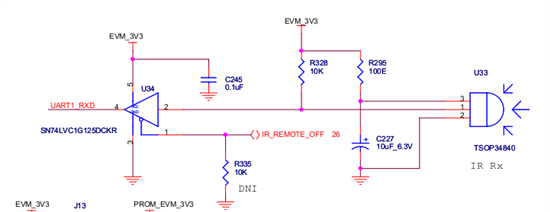On the DM8148 EVM, UART4’s RXD [Pin H25, PINCNTL251 ] is connected to the demodulated output of a IR receiver, through a combination of buffer drivers [IR Demod -> Tri-state Buffer -> Schmitt Bufffe -> UART4_RXD]. The tri-state buffer’s output is pulled low [weak pull-down] and is used by software to turn off the IR remote function.
Under normal operation, it is observed that the IR receiver drives the UART4 RXD line ‘high’ during periods of inactivity and ‘toggles’ [high-> low->high] it when there is IR activity. When we exercise the ‘IR remote off’ function in software, by tri-stating in-line buffer, the UART4 RXD is driven low by the Schmitt buffer, and this action locks up the entire system (software execution halts).
The effect of continuously forcing the UART4 RXD line ‘low’ when UART4 is operating in CIR mode is causing system lock up. This behavior is consistent. What causes this behavior? Is it a HW or a SW issue (we are running the latest EZSDK 5.05.02.00)
The workaround is to force the UART4 RXD line ‘high’ [through a pull-up] when the in-line buffer is tri-stated by software but we would like to know the root cause of the problem.


